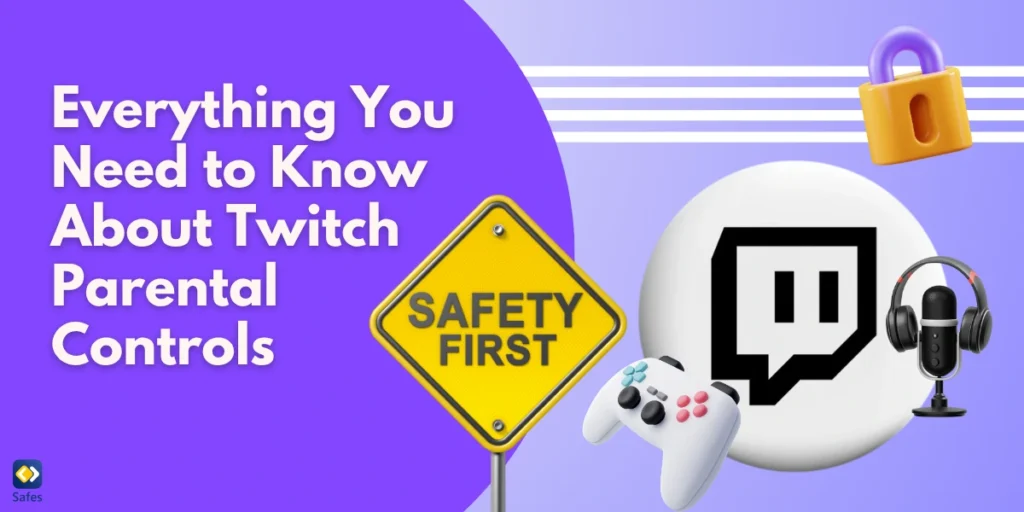Structured bedtime routines provide children with a sense of security, structure, and consistent patterns. Following a simple routine each night can be calming for children, making it easier for them to fall asleep faster and stay asleep longer. A bedtime chart helps parents to set an appropriate bedtime by age and aids in creating a consistent bedtime routine. Are you constantly wondering what a suitable bedtime is for their age? Are you not sure about how many hours of sleep you or your child should get? In this blog, we’ll give an overview of the importance of sleep for children, how much sleep they need, and explain why a bedtime chart by age is helpful. Additionally, we’ll provide tips on how to create a bedtime routine that works for your child and helps them get the sleep they need.
Download and Start Your Free Trial of the Safes Parental Control App
The Importance of Healthy Bedtimes for Children
Sleep is a vital component of a child’s development, and it’s essential to establish a healthy sleep routine. Without adequate sleep, children can develop behavioral issues, crankiness, and even health problems. Research indicates that children who get enough sleep have improved cognitive functions, and better concentration, and are more prone to learning and retaining knowledge. Establishing healthy sleep patterns is essential for a child’s development, which is why it’s critical to establish a consistent bedtime routine. Check out our detailed bedtime chart by age guide and create a bedtime routine that helps your child get the sleep they need.
Recommended Bedtime Chart by Age
Are you wondering what time your little one should be asleep? We’ll provide a handy chart that takes the guesswork out of figuring out the best bedtime for your child. As children grow and develop, their sleep needs change, and a bedtime chart provides a helpful guide for parents to ensure their kids are getting the rest they need.
You might wonder how this chart was created. Researchers have been studying sleep patterns in children for years, and through extensive data analysis, they’ve been able to determine the ideal bedtime based on a child’s age. Factors such as school schedules, extracurricular activities, and family routines were also taken into account when developing the chart.
Following a bedtime chart is beneficial for both children and parents. Kids who get the recommended amount of sleep have improved physical and mental health, better academic performance, and decreased behavioral problems. Not to mention that well-rested kids typically result in happier parents!
It’s important to remember that every child is unique, and their sleep needs may differ from what is recommended on the chart. It’s always best to pay attention to your child’s sleep patterns and adjust accordingly. Keep in mind that screens can dysregulate their sleeping habits. To keep an eye on their internet consumption you can use a parental control app. Safes is a parental control app with a 14-day free trial. Download it for Android, iOS, Windows, and MacOS.

Age-Appropriate Bedtimes
Bedtimes can be a tricky subject for parents, as there is no one right answer that works for every child. Factors such as age, temperament, and lifestyle all come into play when it comes to determining a bedtime routine. However, there are certain age-appropriate bedtimes that can be used as a guideline to ensure your child gets enough rest. In this blog, we’ll explore how bedtimes change as children age, discuss the average bedtime by age, and provide examples of appropriate bedtimes by age.
Bedtimes Change as Children Age
As children grow and develop, their sleep needs by age change. Newborns, for example, may sleep up to 16 hours a day, whereas adolescents may only need 9-10 hours a night. As a general rule, younger children require more sleep than older children, as their bodies are still growing and developing. Additionally, as children get older, they often become more involved in school and extracurricular activities, which can affect the amount of sleep they get.
Examples Of Appropriate Bedtimes by Age
Though every child is unique, there are certain age-appropriate bedtimes, based on sleep requirements by age, that parents can use as a guideline. These average bedtimes are according to the National Sleep Foundation:
- Infants: 6-8 pm
- Toddlers: 7-8 pm
- Preschoolers: 7-8 pm
- School-aged children: 8-9 pm
- Adolescents: 10-11 pm
Of course, every child is different, and these bedtimes may need to be adjusted based on your child’s individual needs to reach their optimal amount of sleep. It’s important to pay attention to your child’s behavior and adjust their bedtime accordingly. If they are consistently tired or cranky during the day, it may be a sign that they need more sleep.
Creating a bedtime sleep chart by age can be a helpful tool for parents trying to establish a bedtime routine. By using age-appropriate bedtimes as a guideline, you can ensure your child gets the rest they need to grow and develop. Remember, every child is different, so be flexible and adjust their bedtime as needed. With a little patience and consistency, you can help your child get the rest they need for a happy, healthy life.

Ideal Bedtime by Age
Bedtimes for children vary depending on their age and daily schedule. You can determine their bedtime by the amount of sleep needed. The American Academy of Pediatrics (AAP) recommends the following sleep time for children:
- Infants (4-12 months): 12-16 hours a day (including naps)
- Toddlers (1-2 years): 11-14 hours a day (including naps)
- What time should a toddler go to bed?
- 18:30 – 19:30 would be ideal, because they reach a deep sleep between 20:00 and midnight.
- Preschoolers: 10-13 hours a day (including naps)
- What time should a 3-years-old go to bed?
- 18:30 – 19:00
- What time should a 4-year-old go to bed?
- 19:00 would be a good bedtime, if your preschooler still enjoys their naps; you can move their time to rest closer to 20:00.
- What time should a 5-year-old go to bed?
- 19:00
- School-age children: 9-12 hours a day, overall, the bedtime of 6 to 11 years old is between 19:00 and 21:00.
- What time should a 6-year-old go to bed?
- If your child has to wake up at 7:00 for school, 19:00 – 21:00 would be a good time to sleep. You can check if they nap at school, and adjust their bedtime accordingly.
- What time should a 7-year-old go to bed?
- 19:00 – 21:00 would be a good time to sleep, you can adjust the specific time to their wake-up time.
- What time should an 8-year-old go to bed?
- 19:00 – 21:00 would be a good time to sleep, you can adjust the specific time to their wake-up time.
- What time should 9-year-olds go to bed?
- 19:00 – 21:00 would be a good time to sleep, you can adjust the specific time to their wake-up time.
- What time should a 10-year-old go to bed?
- 19:00 – 21:00 would be a good time to sleep, you can adjust the specific time to their wake-up time.
- What time should 11-year-olds go to bed?
- 19:00 – 21:00 would be a good time to sleep, you can adjust the specific time to their wake-up time.
- What time should a 12-year-old go to bed?
- If your child has to wake up at 6:30 for school, 20:15 – 21:00 would be an appropriate bedtime.
- Teenagers (13-18 years): 8-10 hours a day
It’s important to note that these are general guidelines and that each child is different. Some children may need 8 hours of sleep while others might need more or even less. It’s also important to establish a consistent bedtime routine to help your child get the sleep they need. You should always consult with your child’s pediatrician if you have any concerns about their sleep habits.
Bedtime Chart by Age: Printable
By using a bedtime chart by age, you can be sure that your child gets the sleep they need. It never gets outdated, because it’s up to date with all ages. Just be sure to customize it with your child’s nap hours. By clicking on the link below, you can download the printable bedtime chart to have at hand.
| Wake-Up Time | ||||||||
| 6:00 | 6:15 | 6:30 | 6:45 | 7:00 | 7:15 | 7:30 | ||
| Age Range | Recommended Hours of Sleep | Sleeping Time | ||||||
| 4-12 months | 12-16 hours | 14:00 – 18:00 | 14:15 – 18:15 | 14:30 – 18:30 | 14:45 – 18:45 | 15:00 – 19:00 | 15:15 – 19:15 | 15:30 – 19:30 |
| 1-2 years | 11-14 hours | 16:00 – 19:00 | 16:15 – 19:15
|
16:30 – 19:30
|
16:45 – 19:45
|
17:00 – 20:00
|
17:15 – 20:15
|
17:30 – 19:30
|
| 3-5 years | 10-13 hours | 17:00 – 20:00 | 17:15 – 20:15 | 17:30 – 20:30 | 17:45 – 20:45 | 18:00 – 21:00 | 18:15 – 21:15 | 18:30 – 21:30 |
| 6-12 years | 9-12 hours | 18:00 – 21:00 | 18:15 – 21:15 | 18:30 – 21:30 | 18:45 – 21:45 | 19:00 – 22:00 | 19:15 – 22:15 | 19:30 – 22:30 |
| 13-18 years | 8-10 hours | 20:00 – 22:00 | 20:15 – 22:15 | 20:30 – 22:30 | 20:45 – 22:45 | 21:00 – 23:00 | 21:15 – 23:15 | 21:30 – 23:30 |
Conclusion
Sleep is a crucial component of our child’s growth and development, so it’s important to establish appropriate bedtimes based on their age. Studies have shown that sleep plays a significant role in cognitive and physical development, plus it’s important for children’s immune systems, emotional regulation, and mental health. Inadequate sleep can lead to behavioral issues, lack of focus, weak memory function, and susceptibility to illnesses like colds, flu, and other viruses.
Final Thoughts on the Importance of Age-Appropriate Bedtimes
It’s not only essential for babies to get adequate sleep, but as kids grow older, the need for sleep is just as critical. Parents should prioritize their child’s bedtime routine and establish age-appropriate bedtimes to guarantee their well-being.
So, if you’re a parent, and you haven’t already done so, it’s time to start creating a bedtime chart by age tonight. Use it to help your children establish healthy sleep patterns that will benefit them throughout their life. A consistent sleep schedule will help them perform better in school, regulate their behaviors, and keep their bodies healthy. Don’t wait – start now!
FAQ
-
How much sleep does a 7-year-old need?
-
A 7-year-old averagely needs 9 – 12 hours of sleep.
-
How much sleep does a 10-year-old need?
-
A 10-year-old averagely needs 9 – 12 hours of sleep.
-
How many hours of sleep should you get per night?
-
8 hours of sleep is adequate for most people.
Your Child’s Online Safety Starts Here
Every parent today needs a solution to manage screen time and keep their child safe online.
Without the right tools, digital risks and excessive screen time can impact children's well-being. Safes helps parents set healthy boundaries, monitor activity, and protect kids from online dangers—all with an easy-to-use app.
Take control of your child’s digital world. Learn more about Safes or download the app to start your free trial today!




